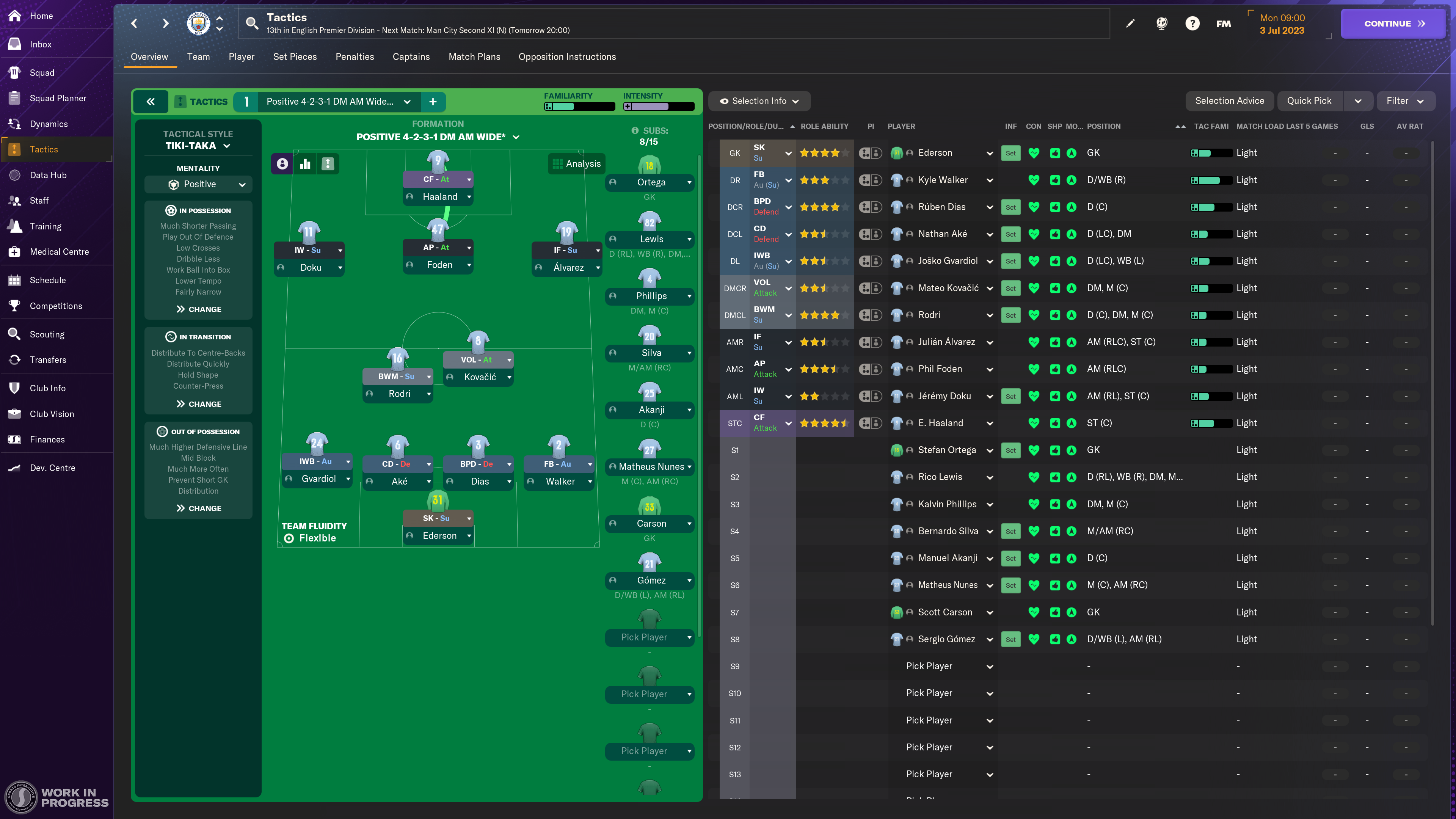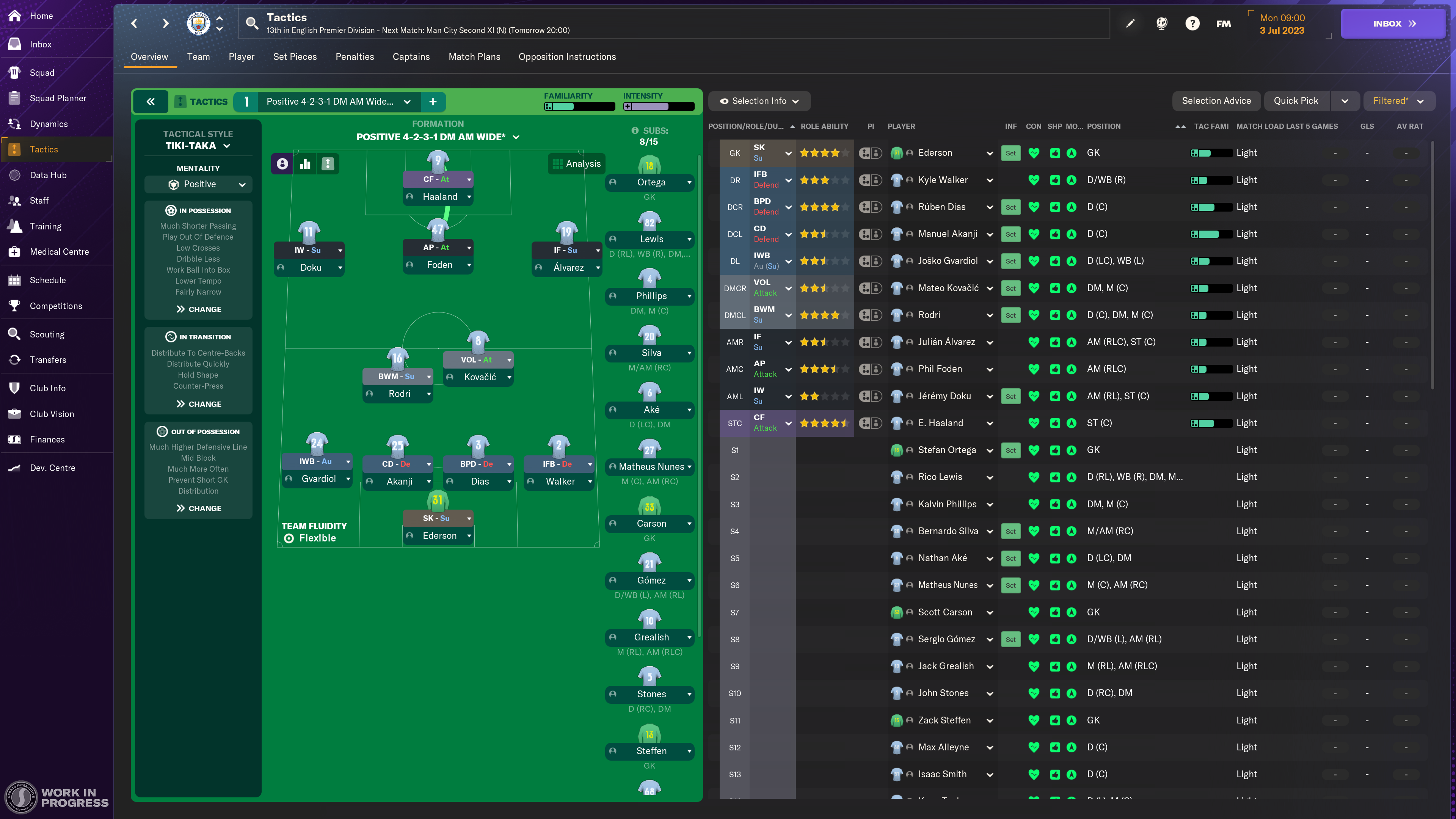
Truer Football Motion, Match Authenticity & Positional Play
TRUER FOOTBALL MOTION, MATCH AUTHENTICITY & POSITIONAL PLAY
Matchdays are the moments that get the adrenaline flowing in every Football Manager career. They’re where tactical visions come to life, underdog stories are written and players win a lifelong place in your heart with their heroics.
With every release of Football Manager, our Match team strive to make those moments feel closer to a perfect simulation of real-world football.
In FM24, the most complete version in the series to-date, the team have vastly improved the way players behave in our engine. From animation locomotion upgrades that improve off-the-ball movement right through to player rotation enhancements that enable you to incorporate more positional play in your tactics, you’ll notice the changes from your first kick-off.
The introduction of a brand-new player role brings you closer to the cutting edge of the professional game, while other roles have had their functionality refined to complement some of our other changes.
We’ve also made upgrades to our ball physics and matchday lighting to level up the immersion, so let’s dive into why this year’s match experience is the best yet.

DELIVERING NEW AVENUES FOR ATTACKING PLAY
Thanks to the likes of Manchester City boss Pep Guardiola, positional play has become one of world football’s most popular principles in recent years.
Put simply, it’s an approach that sees players take up positions on the pitch that help their side to create numerical advantages with passing triangles and diamonds. The intention of these shapes is to create space, give the ball-carrier several passing options and allow the team to progress possession up the pitch towards the final third.
Understandably, many of you have been keen to try and emulate those positional play-driven approaches in FM. Our Match team have strived to deliver you more tools to do so, particularly with regards to improving player rotations on the pitch.
You’ll see that some players, based on their role and those you’ve included around them, can now move into another position while you’re in possession than would be expected from their default starting base.
Take, for example, a 4-2-3-1 with two defensive midfielders where your pivot players are a Segundo Volante and a defensive Ball-Winning Midfielder and the player just behind the striker is an Advanced Playmaker.

Following our rotation changes for FM24, the Advanced Playmaker now recognises the attacking runs of the Segundo Volante in behind. This means that the Advanced Playmaker will move across to open a new channel, freeing up the Segundo Volante to push up as a second number 10 and effectively create a 4-1-4-1 shape in attack. To accommodate this movement, your Ball-Winning Midfielder would occupy a more central position to provide more effective cover.
These rotations work with other aggressive defensive and central midfield roles too, like Roaming Playmakers and Mezzalas. We look forward to seeing you all experiment with this fluidity but in the meantime you can see some of those midfield rotations in action in the video below.
To complement these changes, we’ve also tweaked the behaviour of the Inverted Winger and Inside Forward roles. Now, when they recognise that you’ve got an additional midfield player pushing up into the half space on their side, they will stay wider to accommodate them and help you create more overloads.
On a more defensive note, the Half-Back role has had some alterations for FM24. Now, depending on where you’re using them in a double pivot, it can take up either the left or right centre-back position while you’re in possession.
In summary, these positional rotations mean that your players now behave more intelligently, adjusting their position based on the roles and movement of teammates around them. Your players should have more passing lanes open to them and a better ability to play through the lines, allowing your team’s shape to dynamically adjust between different phases of attack.
A MODERN EVOLUTION: INTRODUCING THE INVERTED FULL-BACK
Better incorporating positional play is just one of this year’s new additions that better reflects modern football trends. Another is a brand-new player role, the Inverted Full-Back.
Popularised by Manchester City’s Kyle Walker and a highly requested addition on our forums, this new role functions as a traditional Full-Back when defending but in possession transitions to become a third central defender.
When the Inverted Full-Back combines with your other central defenders to make a back three, the outermost two function like Wide Centre-Backs. This means that the defender on the side of the pitch where the ball is has licence to move slightly further forward to support the play.
This new role enables you to experiment with three-at-the-back building shapes while defending in a back four, something that many of the world’s top teams are currently doing. It also frees up someone else in your backline to move up into midfield.

LEVELLING UP THE INVERTED WING-BACK
That player pushing into midfield could well be an Inverted Wing-Back on the other side of your defence, as this is another role with much more intelligent and responsive positioning in FM24.
Now, the defensive midfielders are more suited to recognising this movement of the Inverted Wing-Back. This means that when an Inverted Wing-Back pushes up, a deeper-lying defensive midfielder on their side will move across to form a two-man pairing. This adaptation is very similar to the way Rodri tends to dovetail with the full-back on his side of the pitch at Manchester City.
The clip below illustrates the sort of 3-2 build-up shape that combining an Inverted Full-Back and Inverted Wing-Back can achieve.
BUILDING OUT FROM THE BACK WITH AN ENHANCED LIBERO
Manchester City boss Pep Guardiola’s status as a tactical trendsetter came to the fore once again last season with John Stones playing as a centre-back stepping up into midfield.
That ‘John Stones role’ is included in FM24 thanks to significant improvements made to the way the Libero functions.
Available now in both a back four and all three central defensive roles in a back three, the Libero will move up into defensive midfield in a similar way to the Inverted Wing-Back.
In addition to the midfielders adjusting their position to accommodate the Libero’s forward movement, we’ve also ensured that your central defenders suitably adapt to the Libero stepping out of the defensive line.
As such, your central defenders will now alter their behaviour depending on the number of active players in your backline. If there are two, for example, they will function as a traditional centre-back pairing but split further across the pitch to cover space more effectively.
Something to note is that if you play an Inverted Wing-Back and a Libero on the same side of the defensive line, the Libero will not push up. This is because the Inverted Wing-Back has priority when both roles are being asked to transition into the same space.
These changes to the Libero, as well as to the other roles outlined above, ultimately mean that there’ll be greater fluidity and dynamism to your tactics and the way they perform on Matchday. The below clip illustrates a fantastic goal that was created by using some of the upgraded roles in tandem to open up the pitch.
TRUER FOOTBALL MOTION
Outside of their role behaviour, you’ll notice that players now appear more intelligent when they’re moving into positions.
As outlined in our June Development Blog, this is thanks to data we've obtained from a new partner from the real world of professional football. This data greatly improves the authenticity and fluidity of the animations in our games and is a significant leap forward beyond traditional studio-based motion capture.
We've also improved our in-house animation engine, utilising the Inverse Kinematics system to reflect the real-life captured data in the most accurate and realistic way possible.
To make use of the new database of animations, we've introduced Motion Matching. This new system allows us to identify these more realistic animations and directly use them for every player in FM relative to the context of the match.
Motion Matching, in combination with Inverse Kinematics, will bring a lot more fluidity to player movements. You’ll notice these animation changes most with off-the-ball actions like running, pointing and defensive jockeying. Players will now position themselves on the half-turn much more often, meaning that they can receive the ball and turn more easily, again allowing you to play through the opposition more than ever before. Have a look at the clip below to see some of these changes in action.
Ultimately, these changes mean that without any extra processing requirements, you will experience smoother and more fluid player animations than in previous editions of FM.
MORE AUTHENTIC BALL MOVEMENT
In conjunction with the visibly improved player movement across the pitch, we’ve also rewritten our ball physics system to be more accurate to real life.
Our engine now models drag and air resistance more effectively, meaning that the ball will float and spin more authentically. Similarly, deflections will also appear more realistically than they have in previous editions.
Weather is another factor that will affect the movement of the ball, as will things like the temperature or the altitude of the stadium that you’re playing at.
The video below illustrates some of these changes in action.
Supporting these ball physics changes are enhancements to the way your players dribble and finish.
We’ve implemented more authentic ball friction with the ground, meaning that dribbling attempts will be more realistically affected by the pitch and the weather conditions.
Additionally, you’ll notice that your players are now less likely to dribble all the way to the byline before stopping and turning around. Instead, they’ll slow down earlier to face up the opposition defender.
These changes also mean that your players are now able to volley the ball into the ground and are more likely to connect with downward headers when the right situation arises.
ELEVATING YOUR MATCHDAY ENVIRONMENT
The more eagle-eyed of you will have spotted this in the first screenshots of FM24 that were revealed but lighting and pitch textures have been significantly enhanced by our teams.
Day, night and interior lighting have all been upgraded to ensure that you get better colour grading based on the weather, season and time of day. We’ve also updated our fog settings so that the time of day and weather conditions are more obvious in every match.
Pitch textures now have a much sharper and more natural look and feel to them, meaning that every match looks more authentic than it ever has.
The graphic below illustrates how much of an improvement there is between the lighting and pitch textures in FM23, on the left, and those in FM24, on the right.
MOST AUTHENTIC AND IMMERSIVE MATCHDAY YET
Positional rotations and the brand-new Inverted Full-Back player role give you more avenues for tactical experimentation in FM24. With more intelligent player movement, you’ll score some beautifully crafted goals and all of them will be visually elevated by the changes we’ve made to ball physics and lighting.
Head over to our Features Roadmap to discover the wider new additions and improvements that we’ve made for FM24, the most complete edition in the series yet.




Recommended Comments